2019 MERCEDES-BENZ CLA COUPE air condition
[x] Cancel search: air conditionPage 121 of 330
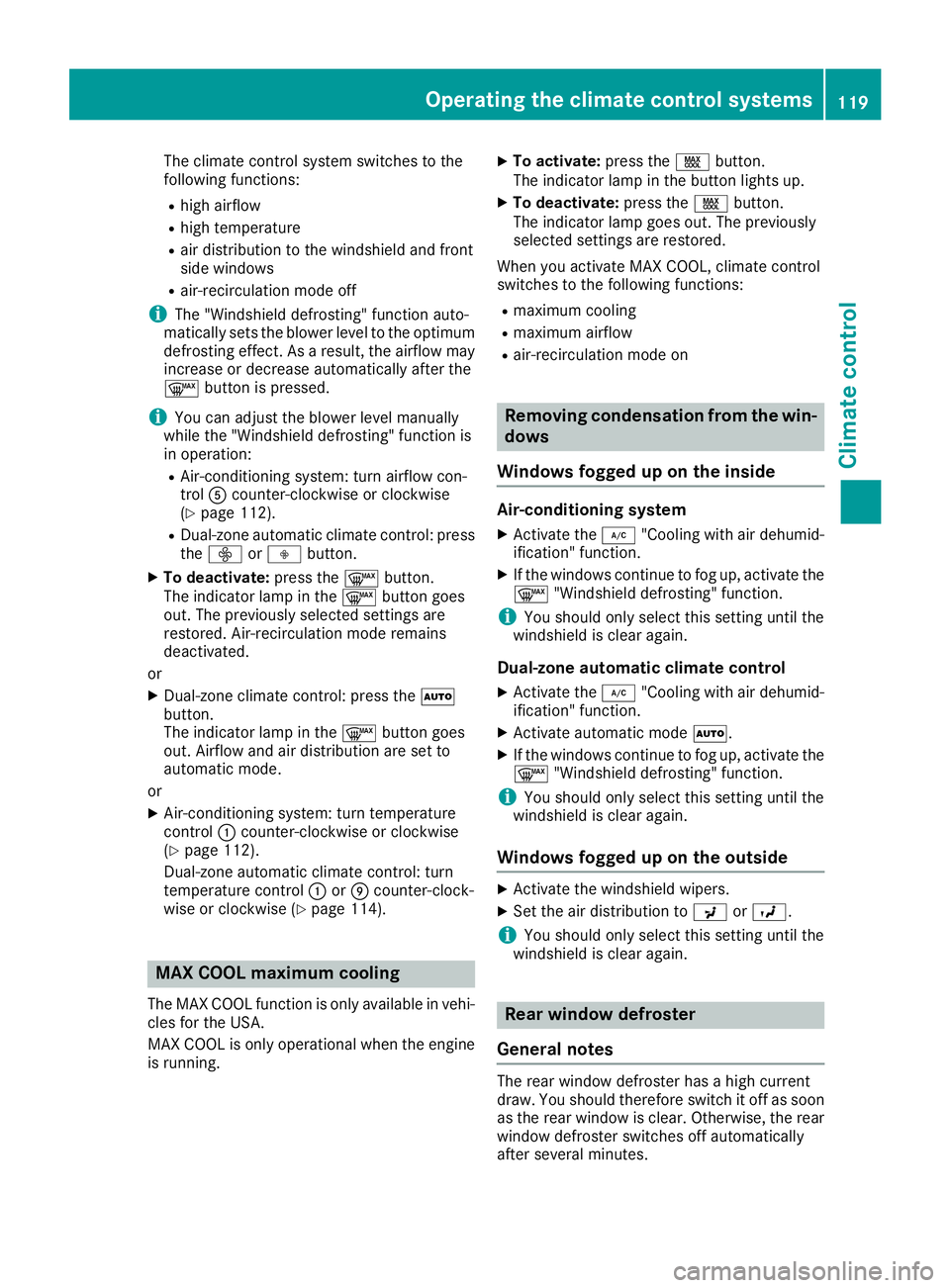
The
climate controlsystem switches tothe
following functions:
R high airflow
R high temperat ure
R air distribution tothe windshield andfront
side windows
R air-recirc ulationmodeoff
i The
"Windshield defrosting"funct ionauto-
matically setstheblower leveltothe optimum
defrost ingeffect .As aresult, theairflow may
increase ordecrease automatically afterthe
0064 button ispressed.
i You
canadjust theblower levelmanually
while the"Windshield defrosting"funct ionis
in operation:
R Air- condit ioning system: turnairflow con-
trol 0083count er-clockwise orclock wise
(Y page 112).
R Dual-zon eautomatic climatecontrol:press
the 00F2 or00F3 button .
X To deactivat e:press the0064 button .
The indicator lampinthe 0064 button goes
out. Thepreviously selectedsettings are
restor ed.Air-recirc ulation moderemains
deactivated.
or
X Dual-zon eclimate control:press the0058
button .
The indicator lampinthe 0064 button goes
out. Airflow andairdistribution aresetto
automatic mode.
or X Air- condit ioning system: turntemperat ure
cont rol0043 count er-clockwise orclock wise
(Y page 112).
Dual-zon eautomatic climatecontrol:turn
temperat urecont rol0043 or006D count er-clock-
wise orclock wise(Ypage 114). MAX
COOL maxim umcooli ng
The MAX COOL functionisonly availabl ein vehi-
cles forthe USA .
MAX COOL isonly operational whentheengine
is runnin g. X
To activat e:press the00C9 button .
The indicator lampinthe button lightsup.
X To deactivat e:press the00C9 button .
The indicator lampgoesout.Thepreviously
selected settings arerestor ed.
When youactivate MAXCOOL, climate control
switches tothe following functions:
R maximum cooling
R maximum airflow
R air-recirc ulationmodeon Removing
condensation fromthewin-
dows
Windows foggeduponthe inside Air-conditioning
system
X Act ivate the005A "Cooling withairdehumid-
ification" function.
X Ifthe windows continue tofog up,activate the
0064 "Windshield defrosting"funct ion.
i You
should onlyselect thissettinguntil the
windshield isclear again.
Dual-zone automat icclimate control
X Act ivate the005A "Cooling withairdehumid-
ification" function.
X Act ivate automatic mode0058.
X Ifthe windows continue tofog up,activate the
0064 "Windshield defrosting"funct ion.
i You
should onlyselect thissettinguntil the
windshield isclear again.
Windows foggeduponthe outside X
Act ivate thewindshield wipers.
X Set theairdistribution to009C or009B.
i You
should onlyselect thissettinguntil the
windshield isclear again. Rear
window defroster
General notes The
rear window defroster hasahigh current
draw. Youshould therefor eswitch itoff assoon
as the rear window isclear. Otherwise, therear
window defroster switchesoffautomatically
after several minutes. Opera
tingtheclimate controlsystems
119Climatecontrol
Page 129 of 330
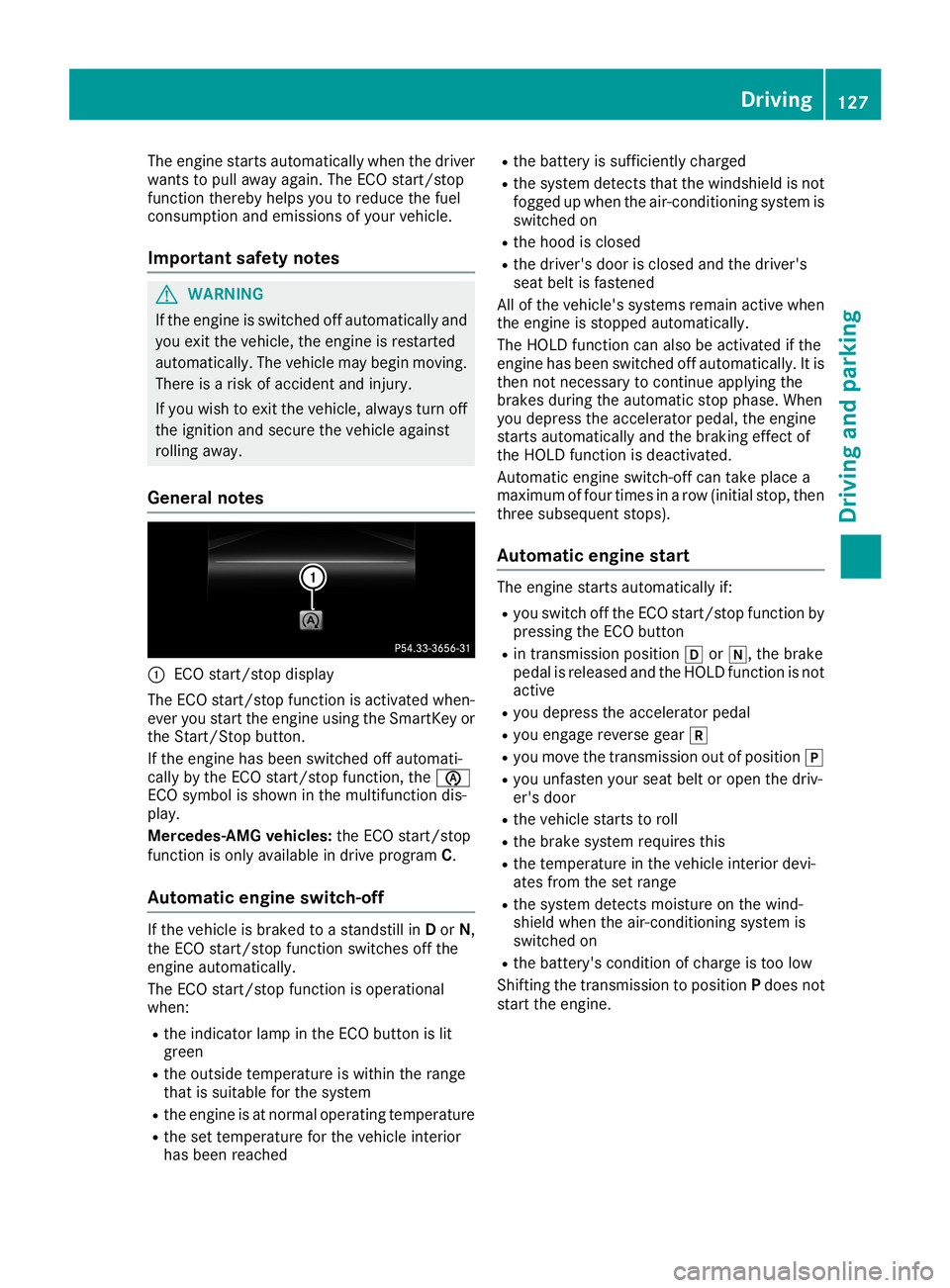
The
engine startsautomatically whenthedriver
wants topull away again. TheECO start/stop
funct ionthereby helpsyoutoreduce thefuel
consumpt ionand emissions ofyour vehicle.
Import antsafety notes G
WARNIN
G
If the engine isswitched offautomatically and
you exit thevehicle, theengine isrestart ed
automatically. Thevehicle maybegin moving.
There isarisk ofaccident andinjury.
If you wish toexit thevehicle, alwaysturn off
the ignition andsecure thevehicle against
rolling away.
General notes 0043
ECO start/stopdisplay
The ECO start/stopfunct ionisactivated when-
ever youstart theengine usingtheSmart Keyor
the Start /Stopbutton .
If the engine hasbeen switched offautomati-
cally bythe ECO start/stopfunct ion,the00D6
ECO symbol isshown inthe multifunct iondis-
play.
Mercedes-AMG vehicles:theECO start/stop
funct ionisonly availabl ein drive program C.
Automa ticengine switch-off If
the vehicle isbraked toastandst illin Dor N,
the ECO start/stopfunct ionswitches offthe
engine automatically.
The ECO start/stopfunct ionisoperational
when:
R the indicator lampinthe ECO button islit
green
R the outside temperat ureiswithin therange
that issuitable forthe system
R the engine isat normal operating temperature
R the settemperat ureforthe vehicle interior
has been reached R
the battery issufficient lycharged
R the system detectsthat thewindshield isnot
fogged upwhen theair-con ditioning systemis
switched on
R the hood isclosed
R the driver's doorisclosed andthedriver's
seat beltisfasten ed
All ofthe vehicle's systemsremainactivewhen
the engine isstopped automatically.
The HOLD functioncan also beactivated ifthe
engine hasbeen switched offautomatically. Itis
then notnecessary tocont inue applyi ngthe
brakes duringtheautomatic stopphase. When
you depress theaccelerator pedal,theengine
start sautomatically andthebraking effectof
the HOLD functionisdeactivated.
Automat icengine switch-offcan take place a
maximum offour times inarow (initial stop,then
three subsequent stops).
Automa ticengine start The
engine startsautomatically if:
R you switch offthe ECO start/stopfunct ionby
pressing theECO button
R in trans mission position 005Bor005C, thebrake
pedal isreleased andtheHOLD functionisnot
active
R you depress theaccelerator pedal
R you engage reverse gear005E
R you move thetrans mission outofposition 005D
R you unfasten yourseatbeltoropen thedriv-
er's door
R the vehicle startsto roll
R the brake system requires this
R the temperat ureinthe vehicle interiordevi-
ates from thesetrange
R the system detectsmoisture onthe wind-
shield whentheair-con ditioning systemis
switched on
R the battery's conditionofcharge istoo low
Shift ingthe trans mission toposition Pdoes not
start theengine. Driving
127Drivingandparking Z
Page 150 of 330
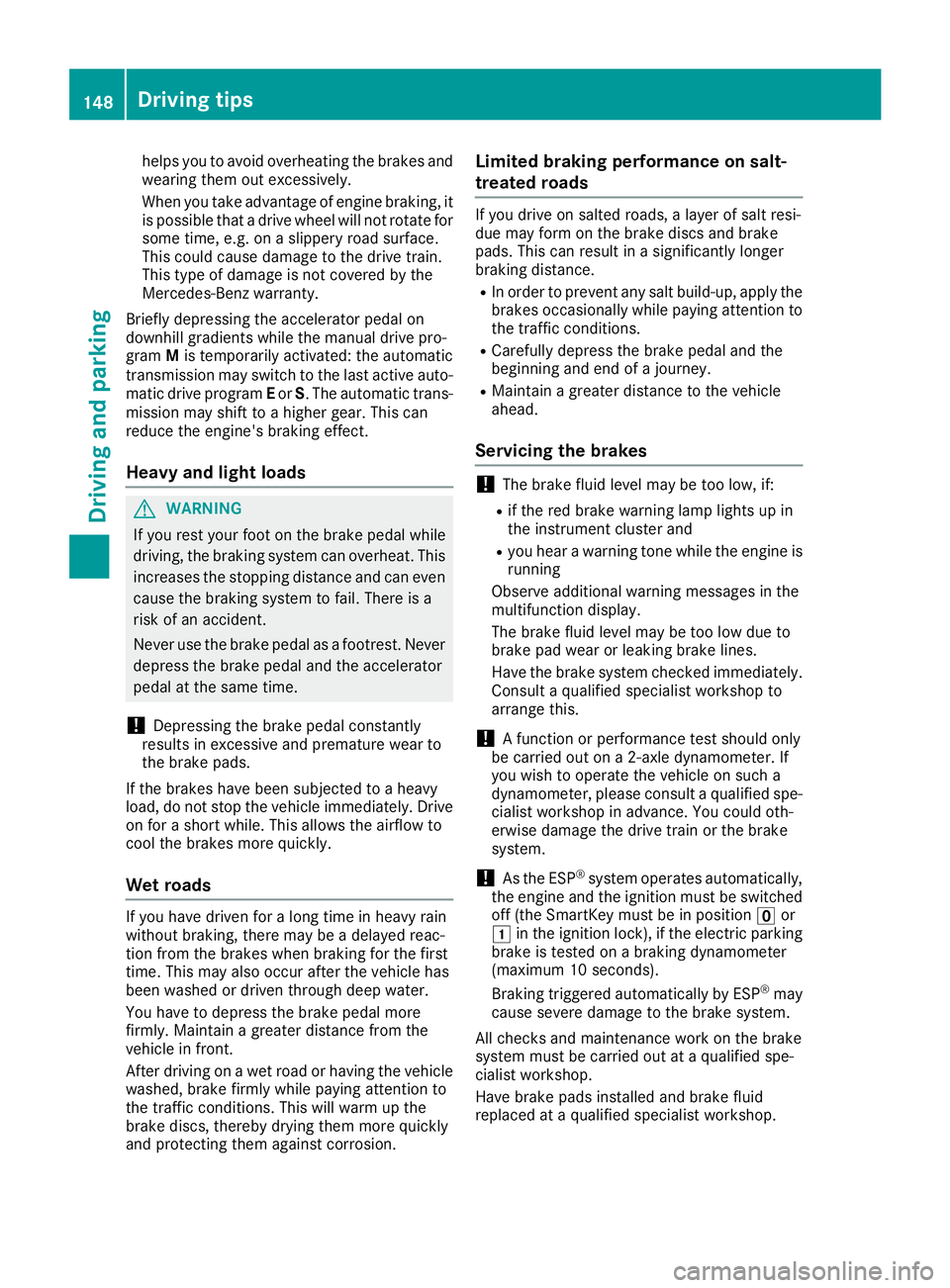
helps
youtoavoid overheating thebrakes and
wearing themoutexcessively.
When youtake advantage ofengine braking, it
is possible thatadrive wheel willnotrotate for
some time,e.g.onaslippery roadsurface.
This could cause damage tothe drive train.
This type ofdamage isnot covered bythe
Mercedes-Ben zwarranty.
Briefly depressing theaccelerator pedalon
downhill gradients whilethemanual drivepro-
gram Mistemporarily activated:theautomatic
transmission mayswitch tothe last active auto-
matic driveprogram Eor S.The automatic trans-
mission mayshift toahigher gear.Thiscan
reduce theengine's brakingeffect.
Heavy andlight loads G
WARNING
If you rest your footonthe brake pedalwhile
driving, thebraking systemcanoverheat. This
increases thestopping distanceandcaneven
cause thebraking systemtofail. There isa
risk ofan accident.
Never usethebrake pedalasafootrest .Never
depress thebrake pedalandtheaccelerator
pedal atthe same time.
! Depressing
thebrake pedalconstantly
results inexcessive andpremature wearto
the brake pads.
If the brakes havebeen subjected toaheavy
load, donot stop thevehicle immediately. Drive
on for ashort while. Thisallow sthe airflow to
cool thebrakes morequickly.
Wet roads If
you have driven foralong time inheavy rain
without braking, theremaybeadelay edreac-
tion from thebrakes whenbraking forthe first
time. Thismay alsooccur afterthevehicle has
been washed ordriven through deepwater.
You have todepress thebrake pedalmore
firmly. Maintain agreater distance fromthe
vehicle infront .
Aft erdriving onawet road orhaving thevehicle
washed, brakefirmlywhilepayingattent ionto
the traffic conditions .This willwarm upthe
brake discs, thereby dryingthemmore quickly
and protect ingthem against corrosion. Limited
braking performanceonsalt-
treat edroads If
you drive onsalted roads, alaye rof salt resi-
due may form onthe brake discsandbrake
pads. Thiscanresult inasignificantly longer
braking distance.
R Inorder toprevent anysalt build -up,apply the
brakes occasionally whilepayingattent ionto
the traffic conditions .
R Carefull ydepress thebrake pedalandthe
beginning andend ofajourney.
R Maintain agreater distance tothe vehicle
ahead.
Servicing thebrakes !
The
brake fluidlevel maybetoo low, if:
R ifthe red brake warning lamplights upin
the instrumen tcluster and
R you hear awarning tonewhile theengine is
running
Observe additional warningmessages inthe
multifunction display.
The brake fluidlevel maybetoo low due to
brake padwear orleaking brakelines.
Have thebrake system checkedimmediately.
Consult aqual ified specialist workshop to
arrange this.
! A
funct ionorperformance testshould only
be carried outona2-axle dynamometer. If
you wish tooperate thevehicle onsuch a
dynamometer, pleaseconsult aqual ified spe-
cialist workshop inadvance. Youcould oth-
erwise damage thedrive trainorthe brake
system.
! As
the ESP ®
system operates automatically ,
the engine andtheignition mustbeswitched
off (the SmartKey mustbeinposition 0092or
0047 inthe ignition lock),ifthe electric parking
brake istested onabraking dynamometer
(maximum 10seconds).
Braking triggered automatically byESP ®
may
cause severe damage tothe brake system.
All check sand maintenanc ework onthe brake
system mustbecarried outataqual ified spe-
cialist workshop.
Have brake padsinstalled andbrake fluid
replaced ataqual ified specialist workshop. 148
Driving
tipsDriving andparking
Page 178 of 330

Switching
onBlind SpotAssist
X Make surethatBlind SpotAssist isactivated
in the on-board computer (Ypage 188).
X Turn theSmartK eytoposition 0048inthe igni-
tion lock.
Warning lamps0043inthe exterior mirrorslight
up red forapproximately 1.5seconds and
then turnyellow .
Lane Keeping Assist General
notes Lane
Keeping Assistmonitor sthe area infront of
your vehicle bymeans ofmultifunct ioncam-
era 0043which isattached behindthetop ofthe
windshield. LaneKeeping Assistdetectslane
markings onthe road andcanwarn youbefore
you leave yourlaneuninten tionally.
This funct ionisavaila bleinthe range between
40 mph and120 mph (60km/h and200 km/h ).
A warning maybegiven ifafront wheel passes
over alane marking. Itwill warn youbymeans of
intermit tentvibration inthe steering wheelfor
up to1.5 seconds.
Import antsafety notes G
WARNING
Lane Keeping Assistcannot alwaysclearly
detect lanemarkings.
In such cases, LaneKeeping Assistcan:
R give anunnecessary warning
R not give awarning
There isarisk ofan accident.
Always payparticular attentiontothe traffic
situation andkeep within thelane, especially
if Lane Keeping Assistalertsyou. G
WARNING
The Lane Keeping Assistwarning doesnot
return thevehicle tothe original lane.There is
a risk ofan accident.
You should alwayssteer, brakeoraccelerate
yourself, inparticular ifwarned byLane Keep-
ing Assist.
If you failtoadapt yourdriving style,LaneKeep-
ing Assist canneither reducetherisk ofan acci-
dent noroverride thelaws ofphysics. Lane
Keeping Assistcannot takeintoaccount the
road, traffic andweather condition s.Lane Keep-
ing Assist ismerely anaid. You areresponsible
for the distance tothe vehicle infront ,for vehi-
cle speed, forbraking ingood timeandforstay-
ing inyour lane.
The Lane Keeping Assistdoesnotkeep thevehi-
cle inthe lane.
The system maybeimpaired ormay notfunct ion
if:
R there ispoor visibility, e.g.due toinsufficient
illumi nation ofthe road, ordue tosnow, rain,
fog orspray
R there isglare, e.g.from oncomin gtraffic, the
sun orreflection fromother vehicles (e.g.if
the road surface iswet)
R the windshield isdirty, fogged up,damaged or
covered, forinstanc eby astick er,inthe vicin-
ity ofthe camera
R there arenoorseveral unclear lanemarkings
for one lane, e.g.roadworks
R the lane markings areworn away,dark orcov-
ered up,e.g. bydirt orsnow
R the distance tothe vehicle infront istoo short
and thus thelane markings cannotbedetec-
ted
R the lane markings changequickly, e.g.lanes
branch off,cross oneanother ormerge
R the road isnarrow andwinding
R there arehighly variable shadecondition son
the roadway
Switching onLane Keeping Assist
X Switch onAct ive Lane Keeping Assistusing
the on-board computer; todo so, select
Standard Standard
orAdaptive Adaptive
(Ypage 176).
If you drive atspeeds above40mph
(60 km/h) andlane markings aredetect ed,
the lines inthe assistance graphicareshown 176
Driving
systemsDriving andparking
Page 223 of 330
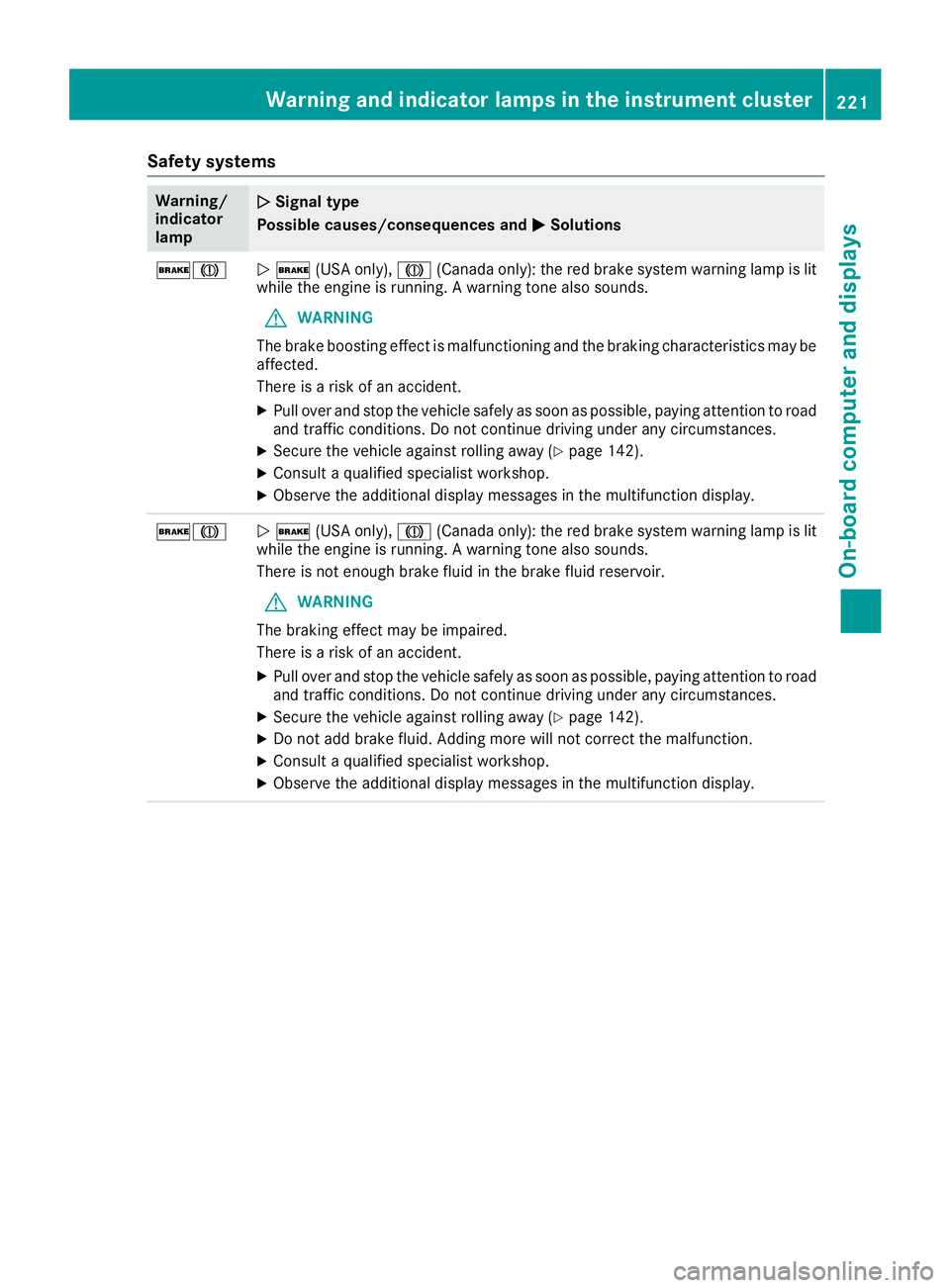
Safety
systems Warning/
indicator
lamp 00510051
Signal type
Possible causes/co nsequences and0050 0050
Solutions 0027004D
0051
0027 (USAonly), 004D(Canada only):thered brake system warning lampislit
while theengine isrunning. Awarning tonealsosounds.
G WARNING
The brake boosting effectismalfunction ingand thebraking characterist icsmay be
affected.
There isarisk ofan accident.
X Pull over andstop thevehicle safelyassoon aspossible, payingatten tiontoroad
and traffic condition s.Do not cont inue driving underanycircumst ances.
X Secure thevehicle against rollingaway(Ypage 142).
X Consult aquali fiedspecialist workshop.
X Observe theadditional displaymessages inthe multifunct iondisplay . 0027004D
0051
0027 (USAonly), 004D(Canada only):thered brake system warning lampislit
while theengine isrunning. Awarning tonealsosounds.
There isnot enough brakefluidinthe brake fluidreservoir.
G WARNING
The braking effectmaybeimpaired.
There isarisk ofan accident.
X Pull over andstop thevehicle safelyassoon aspossible, payingatten tiontoroad
and traffic condition s.Do not cont inue driving underanycircumst ances.
X Secure thevehicle against rollingaway(Ypage 142).
X Do not add brake fluid.Adding morewillnotcorrect themalfunction .
X Consult aquali fiedspecialist workshop.
X Observe theadditional displaymessages inthe multifunct iondisplay . War
ning andindicator lampsin the instrum entcluster
221On-board computerand displays Z
Page 230 of 330
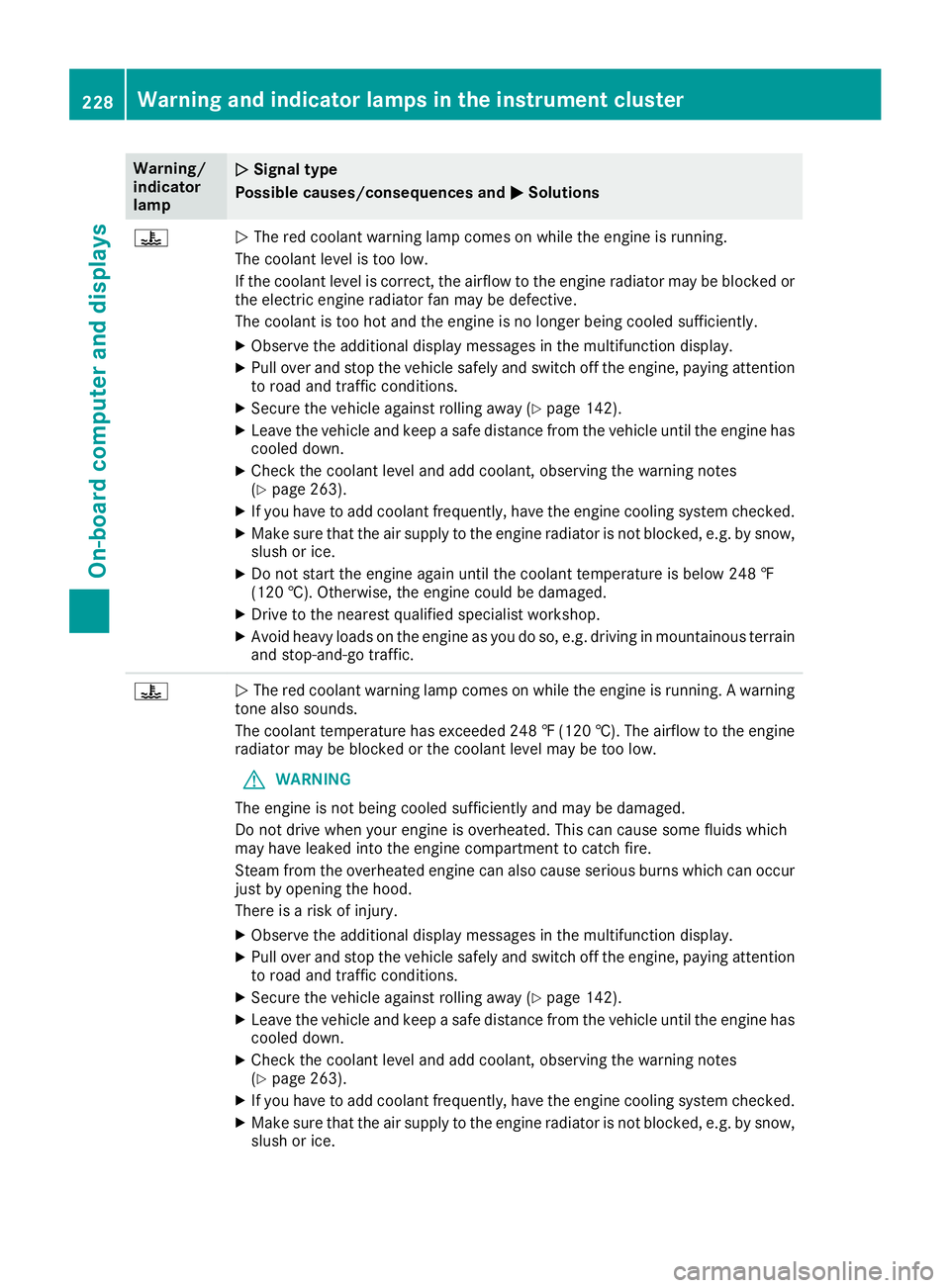
Warning/
indic ator
lamp 00510051
Sign altype
Poss iblecause s/cons equen cesand 0050 0050
Sol utions 00AC
0051
The redcoola ntwar ning lamp comes onwhi lethe engine isrunning.
The coola ntleve lis too low.
If the coola ntleve lis correct, theairfl owtothe engine radiator may beblocked or
the electric engineradiator fanmay bedefective .
The coola ntistoo hotand theengine isno longer being coole dsuffi ciently .
X Observe theadditiona ldisp laymessa gesinthe multi function display.
X Pul lover andstop thevehicl esafel yand switch offthe engine, paying attention
to road andtraffic conditions.
X Secure thevehicl eaga inst rolling awa y(Y pag e142).
X Leave thevehicl eand keep asafe dista ncefrom thevehicl euntil theengine has
coole ddow n.
X Che ckthe coola ntleve land add coola nt,obser vingthewarni ngnotes
(Y pag e263).
X Ifyou have toadd coola ntfrequ ently, havetheengine coolingsystem checked.
X Make surethattheairsup plytothe engine radiator isnot blocked ,e.g. bysnow,
slu sh orice.
X Do not start theengine againuntil thecoola nttempera tureisbel ow 248 ‡
(120 †).Otherwi se,the engine couldbe dama ged.
X Drive tothe neares tqua lified speci alist worksho p.
X Avoid heavyloa dson the engine asyou doso, e.g. drivi nginmountai nousterrain
and stop-and-go traffic. 00AC
0051
The redcoola ntwar ning lamp comes onwhi lethe engine isrunning. Awarni ng
tone alsosound s.
The coola nttempera turehasexceede d248 ‡(120 †).The airflow tothe engine
radi ator may beblocked orthe coola ntleve lmay betoo low.
G WARNING
The engine isnot being coole dsuffi ciently andmay bedama ged.
Do not drive whenyou rengine isoverhe ated.Thiscancausesome fluids which
may have leaked into theengine compartment tocatch fire.
Steam fromtheoverhe atedengine canalso cau seseri ous burns whichcan occur
just byopeni ngthe hood .
There isarisk ofinjury .
X Obse rvethe additiona ldisp laymessa gesinthe multifunction displa y.
X Pul lover andstop thevehi clesafe lyand switch offthe engine, paying attention
to road andtraffic conditio ns.
X Secure thevehi cleaga inst rolling away (Y pag e142) .
X Leav ethe vehi cleand keep asafe dista ncefrom thevehi cleuntil theengine has
coole ddow n.
X Che ckthe coola ntleve land add coola nt,obse rving thewarning notes
(Y pag e263) .
X Ifyou have toadd coola ntfrequ ently, havetheengine coolingsys tem checked.
X Make surethattheairsup plytothe engine radiator isnot blocked, e.g.bysnow,
slu sh orice. 228
Warning
andindicator lamps inthe instrum entclusterOn-b oard comput erand displays
Page 269 of 330
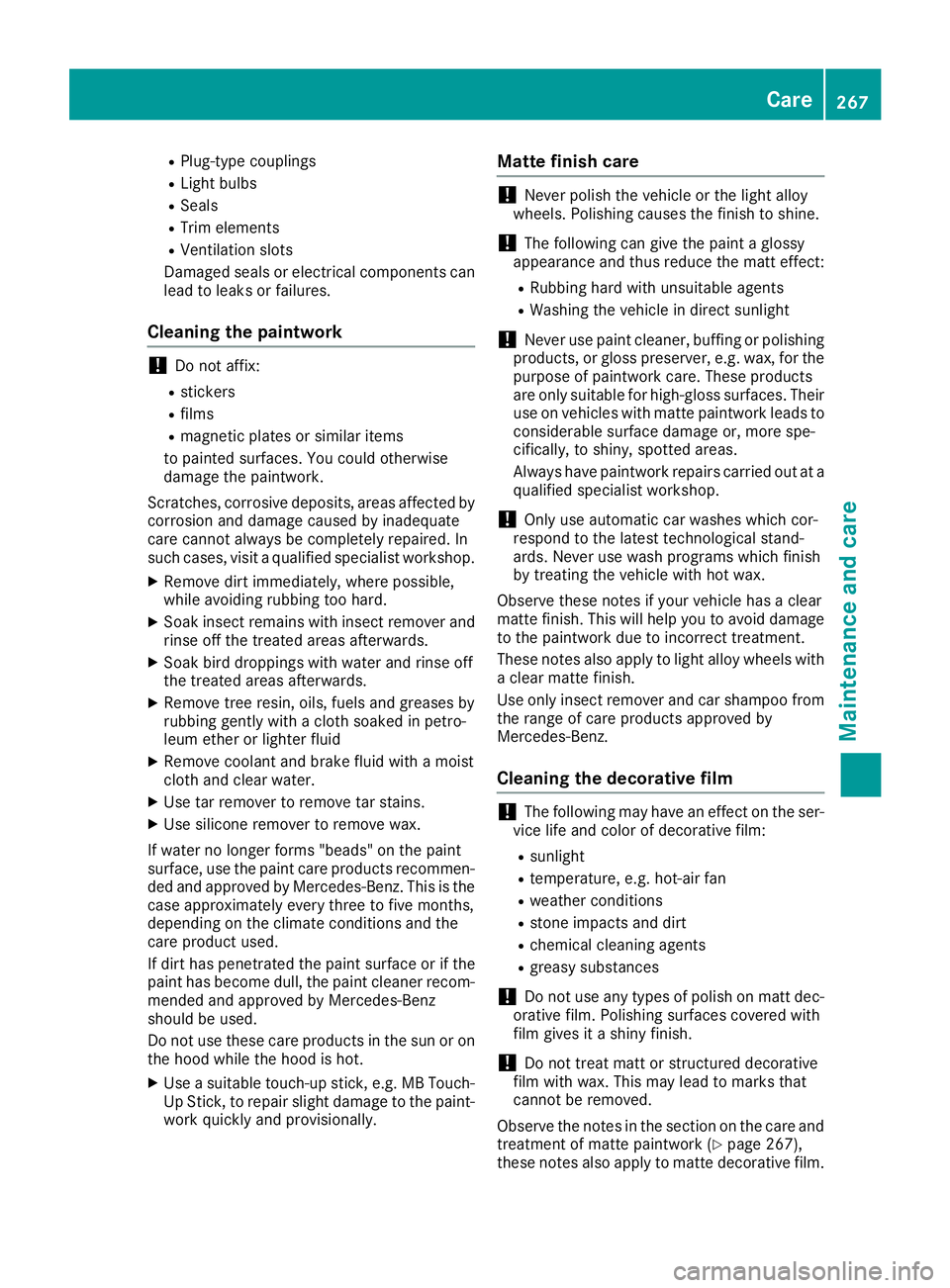
R
Plug-type couplings
R Light bulbs
R Seals
R Trim elements
R Vent ilation slots
Damaged sealsorelectric alcompon entscan
lead toleaks orfailures.
Cleaning thepaint work !
Do
not affix:
R stick ers
R films
R magnetic platesorsimilar items
to painted surfaces. Youcould otherwise
damage thepaintwork .
Scr atches, corrosivedeposits, areasaffectedby
corros ionand damage causedbyinadequate
care cannotalway sbe completely repaired.In
such cases, visitaqualified specialist workshop.
X Remove dirtimmediately, wherepossible,
while avoiding rubbingtoohard.
X Soak insect remains withinsect remover and
rinse offthe treat edareas afterwards.
X Soak birddroppings withwater andrinse off
the treat edareas afterwards.
X Remove treeresin, oils,fuels andgreases by
rubbing gentlywith acloth soaked inpetro-
leum ether orlighter fluid
X Remove coolantandbrake fluidwithamoist
cloth andclear water.
X Use tarremover toremove tarstains.
X Use silicone remover toremove wax.
If water nolonger forms"beads" onthe paint
surface, usethepaint careproducts recommen-
ded andapproved byMercedes- Benz.This isthe
case approximately everythreetofive mont hs,
depending onthe climate conditionsandthe
care product used.
If dirt has penetr atedthepaint surface orifthe
paint hasbecome dull,thepaint cleaner recom-
mended andapproved byMercedes- Benz
should beused.
Do not use these careproducts inthe sun oron
the hood while thehood ishot.
X Use asuitable touch-upstick ,e.g. MBTouch-
Up Stic k,to repair slightdamage tothe paint-
work quickly andprovisionally. Mat
tefinish care !
Never
polish thevehicle orthe light alloy
wheels. Polishing causesthefinish toshine.
! The
following cangive thepaint aglossy
appearance andthus reduce thematt effect :
R Rubbing hardwithunsuitable agents
R Washing thevehicle indirect sunlight
! Never
usepaint cleaner, buffingorpolishing
products, orgloss preserver, e.g.wax, forthe
purpose ofpaintwork care.These products
are only suitable forhigh-gloss surfaces.Their
use onvehicles withmattepaintwork leadsto
cons iderable surfacedamage or,more spe-
cifically, toshiny, spottedareas.
Always havepaintwork repairscarried outata
qualified specialist workshop.
! Only
useautomatic carwashes whichcor-
respond tothe latest technological stand-
ards. Never usewash programs whichfinish
by treat ingthe vehicle withhotwax.
Observe thesenotesifyour vehicle hasaclear
matt efinish. Thiswillhelp youtoavoid damage
to the paintwork duetoincor recttreat ment .
These notesalso apply tolight alloy wheels with
a clear mattefinish.
Use only insect remover andcarshampoo from
the range ofcare products approved by
Mercedes- Benz.
Cleaning thedecorat ivefilm !
The
following mayhave aneffect onthe ser-
vice lifeand color ofdecorative film:
R sunlight
R temperat ure,e.g.hot-airfan
R weather conditions
R ston eimpacts anddirt
R chemical cleaningagents
R greasy substanc es
! Do
not use anytypes ofpolish onmatt dec-
orative film.Polishing surfacescoveredwith
film gives itashiny finish.
! Do
not treat mattorstruc tured decorative
film with wax. Thismay lead tomarks that
cann otbe removed.
Observe thenotesinthe sect iononthe care and
treat ment ofmatt epaintwork (Ypage 267),
these notesalso apply tomatt edecorative film. Care
267Maintenance andcare Z
Page 295 of 330
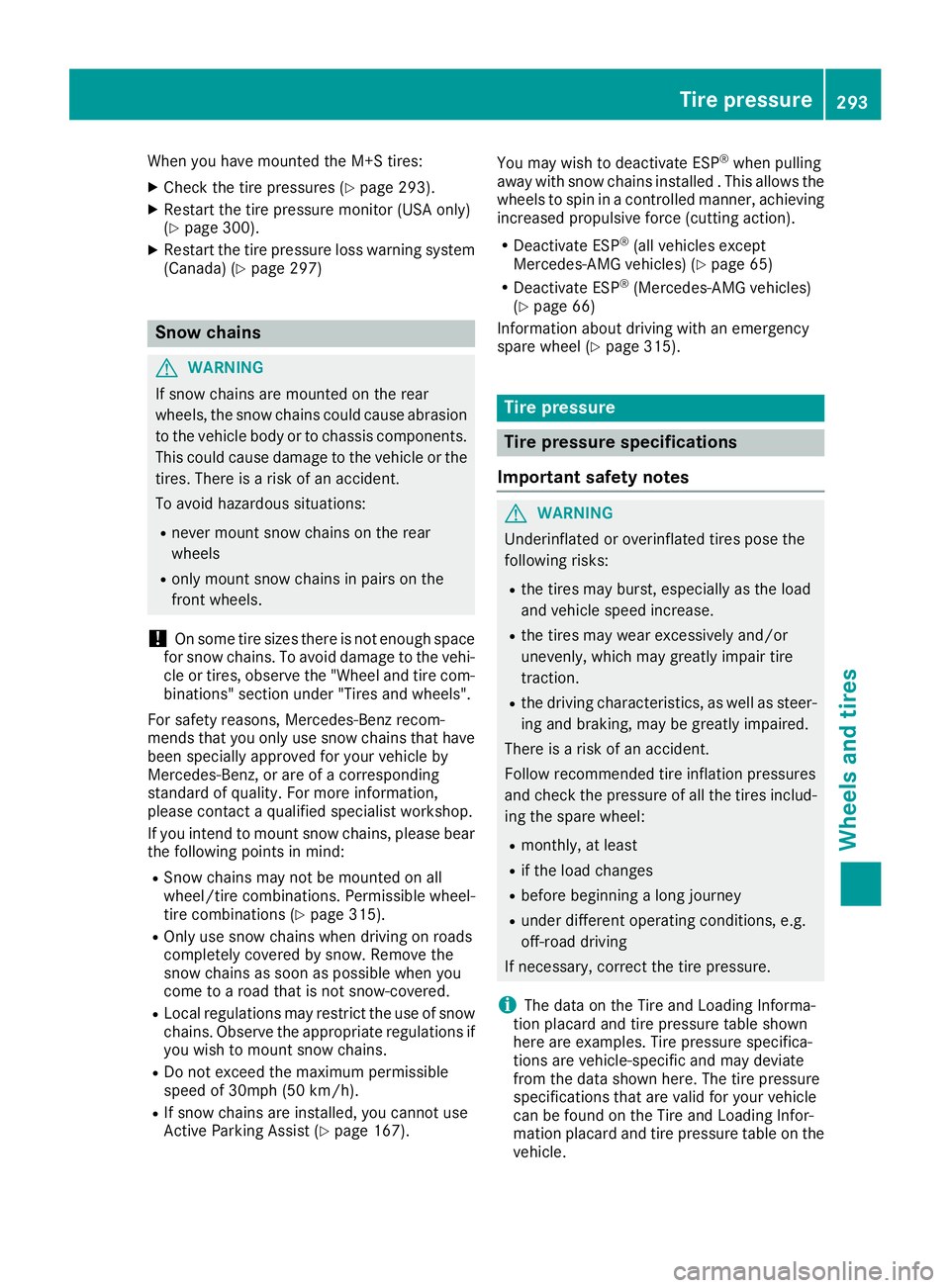
When
youhave mount edthe M+S tires:
X Check thetire pressures (Ypage 293).
X Restart thetire pressure monitor(USA only)
(Y page 300).
X Restart thetire pressure losswarning system
(Canada) (Ypage 297) Snow
chains G
WARNIN
G
If snow chains aremount edon the rear
wheels, thesnow chains couldcause abrasion
to the vehicle bodyortochassis compon ents.
This could cause damage tothe vehicle orthe
tires. There isarisk ofan accident .
To avoid hazardous situations:
R never mount snowchains onthe rear
wheels
R only mount snowchains inpairs onthe
fron twheels.
! On
some tiresizes there isnot enough space
for snow chains. Toavoid damage tothe vehi-
cle ortires, observe the"Wheel andtirecom-
bination s"sect ionunder "Tiresandwheels".
For safety reasons, Mercedes- Benzrecom-
mends thatyouonly usesnow chains thathave
been specially approved foryour vehicle by
Mercedes- Benz,or are ofacorr esponding
standard ofquality. Formore inform ation,
please contactaqualified specialist workshop.
If you inten dto mount snowchains, pleasebear
the following pointsinmind:
R Sno wchains maynotbemount edon all
wheel/tire combinations.Permissible wheel-
tire combin ations(Ypage 315).
R Only usesnow chains whendriving onroads
complet elycovered bysnow. Remove the
snow chains assoon aspossible whenyou
come toaroad thatisnot snow-c overed.
R Local regulations mayrestr ictthe use ofsnow
chains. Observe theappropriate regulationsif
you wish tomount snowchains.
R Do not exceed themaximum permissible
speed of30mph (50km/ h).
R Ifsnow chains areinstalled, youcann otuse
Act ive Parking Assist(Ypage 167). You
may wish todeactivat eES P®
when pulling
away withsnow chains installed .This allows the
wheels tospin inacont rolled manner,achieving
incr eased propulsive force(cutt ingaction ).
R Deact ivateESP®
(all vehicles except
Mercedes- AMGvehicles) (Ypage 65)
R Deact ivateESP®
(Mercedes- AMGvehicles)
(Y page 66)
Inf ormation aboutdriving withanemergen cy
spare wheel (Ypage 315). Tir
epr essure Tir
epr essure specifications
Impor tantsafety notes G
WARNIN
G
Underin flatedoroverinf latedtirespose the
following risks:
R the tires mayburst, especially asthe load
and vehicle speedincrease.
R the tires maywear exces sively and/or
unevenly, whichmaygreatly impairtire
trac tion.
R the driving charact eristics,as well assteer-
ing and braking, maybegreatly impaired.
There isarisk ofan accident .
Follow recomm endedtireinflation pressures
and check thepressure ofall the tires includ-
ing the spare wheel:
R mont hly,atleast
R ifthe load changes
R before beginnin galong journ ey
R under differen toperating conditions,e.g.
off- road driving
If neces sary,correctthe tire pressure.
i The
data onthe Tire andLoading Informa-
tion placard andtirepressure tableshown
here areexamples. Tirepressure specifica-
tions arevehicle-s pecificandmay deviate
from thedata shown here.Thetirepressure
specificat ionsthatarevalid foryour vehicle
can befound onthe Tire andLoading Infor-
mation placard andtirepressure tableonthe
vehicle. Tir
epr essure
293Wheelsandtires Z